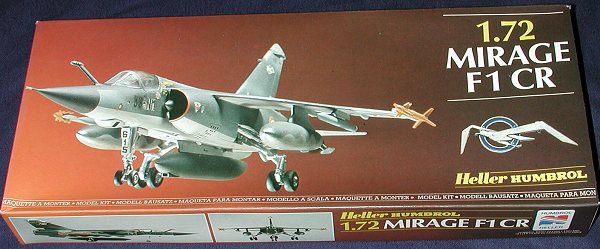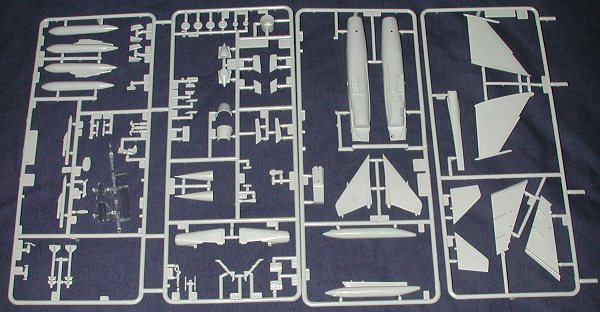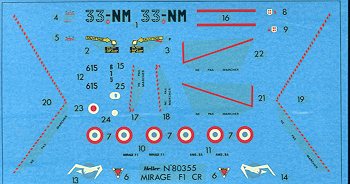
|
KIT: |
Heller 1/72 Mirage F.1CR |
|
KIT # |
355 |
|
PRICE: |
$10.00, in the mid-1980s |
|
DECALS: |
One aircraft |
|
REVIEWER: |
|
|
NOTES: |
|

|
HISTORY |
After the success of the Mirage III/V family, the folks at Dassault were looking to the next generation of aircraft. What emerged was the Mirage F.1. This aircraft was a lot more conventional looking in terms of the wing, but the fuselage was quite reminiscent of the earlier Mirage III.
However, the F.1 was basically designed to have a pretty good ground attack capability as well. In typical French fashion, there were a number of different variants that were enhanced for either air to air abilities or ground attack abilities. Most of the ground attack versions were sold overseas where the F.1 did quite well to African and Central American countries. It was also heavily pushed as a NATO replacement for the F-104, but only Spain bought the aircraft, most other countries opting for the F-16 or some other aircraft.
All French Mirage F.1s were F.1Cs (C for chasse or interceptor). Later it was determined that a replacement would be needed for the Mirage IIIR recce birds that were getting to the end of their life span. It was decided to produce more Mirage F.1s, but make them F.1CRs, capable of carrying cameras as well as being able to perform other tasks like interception and ground attack. The camera would be carried in a pod under the belly of the aircraft, thus freeing it up to carry a weapons load if needed.
This is the version that has been sent overseas to the many hot-spots around the world that France has been involved in policing. This includes Desert Storm and the Balkans, where the F.1CR operated in a variety of missions and did extremely well.
|
THE KIT |

Heller's kit of the F.1 was one of the earlier in 1/72 to appear. I believe that Airfix actually beat them to the punch in getting a 1/72 kit out when the aircraft first appeared. However, unlike many other planes, the F.1 did not change in overall appearance from prototype to production so we are not stuck with a prototype being boxed as a production plane as so often happens.
There are four rather large sprues of light grey plastic and a small one of clear for the two-piece canopy. This is an early 80s kit so has raised panel lines. Parts are well molded, though most of them suffer from ejector pin marks. In most cases they are in places that can be easily removed, but some with take a bit of effort. Like I said, an early 80's kit. There are also a few sink marks on some of the thicker parts like the bang seat (which is a bit basic and should be replaced if are so inclined).
You'll notice several blank areas on the sprues as this kit is also issued as a two seater. Because of that, the fuselage is in four parts; a rear section common to both and a front piece for either the singe or twin seat aircraft. The cockpit itself is fine for the time with a tub, seat, stick and instrument panel. Detailing on the panel and consoles is raised so some dry-brushing will bring out detail.
Underside thingies are the recce pod (rather basically done) for the centerline with twin fuel tanks, and what look like ECM pods under the wings. Holes are predrilled for these items. On the wing tips are so-so air to air missiles. Other options are open or closed canopy and open or closed speedbrakes. There is also a refueling probe for the front of the canopy. Probably the most difficult part of construction will be the main landing gear. They are made of multiple pieces that require careful alignment.
 Instructions are typical Heller
with several construction steps. An additional sheet shows the decal placement
and paint information as well as construction info in all the non-French
languages! Color references are, of course, for Humbrol paints, but since
Humbrol frequently changes paint numbers, I'm not sure they are for the current
batch. Decals are for an aircraft from the 33rd reconnaissance wing, which
previously flew Mirage IIIRs. These decals are on a dark blue background which
is a first for me. Generally, Heller decals work ok, but I'd suggest replacing
them with aftermarket. There are several sheets available for the F.1 and F.1CR.
You can build this kit as a regular F.1 by leaving off the under nose 'bump' and
perhaps the refueling probe, though many F.1s were retrofitted.
Instructions are typical Heller
with several construction steps. An additional sheet shows the decal placement
and paint information as well as construction info in all the non-French
languages! Color references are, of course, for Humbrol paints, but since
Humbrol frequently changes paint numbers, I'm not sure they are for the current
batch. Decals are for an aircraft from the 33rd reconnaissance wing, which
previously flew Mirage IIIRs. These decals are on a dark blue background which
is a first for me. Generally, Heller decals work ok, but I'd suggest replacing
them with aftermarket. There are several sheets available for the F.1 and F.1CR.
You can build this kit as a regular F.1 by leaving off the under nose 'bump' and
perhaps the refueling probe, though many F.1s were retrofitted.
|
CONCLUSIONS |
Though a bit long in the tooth, the Heller kit should make a decent model. Those seeking a newer mold will be better off with the ESCI or the Hasegawa kit, both of them at a higher initial cost. For those who just want a nice model, this one should fill the bill as it can often be found for under $10.
Review kit courtesy of my kit collection.
If you would like your product reviewed fairly and fairly quickly by a site that has well over 100,000 visitors a month, please contact me or see other details in the Note to Contributors.